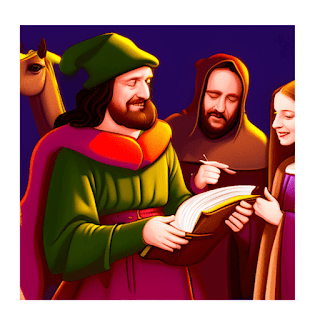Mastering Characterization in The Canterbury Tales: A Guide
Understanding The Prologue's Characterization Techniques in The Canterbury Tales
A Comprehensive Guide to Characterization Techniques in The Canterbury Tales' Prologue
Discover the techniques used to create vivid characters in The Canterbury Tales' prologue. Learn how to master characterization to create rich and compelling narratives.
The Prologue to the Canterbury Tales is a masterful work of characterization, in which Chaucer introduces a diverse cast of characters through vivid and detailed descriptions. Each character is carefully crafted with unique traits, quirks, and flaws, allowing them to stand out as individuals and contribute to the overall richness and complexity of the narrative. In this essay, we will explore the techniques of characterization that Chaucer employs in the Prologue, with reference to each character in the text.
The first technique of characterization that Chaucer employs is physical description. He uses precise and detailed language to describe each character's appearance, including their clothing, body shape, and facial features. For example, in his description of the Knight, Chaucer notes that "Of fustian he wered a gypon / Al bismotered with his habergeon" (5-6). This description not only provides information about the Knight's clothing, but also suggests that he is a seasoned warrior, as his habergeon (a type of chainmail) is stained with battle scars.
Chaucer also uses direct characterization; in which he explicitly states a character's personality traits or motivations. For example, when introducing the Clerk, Chaucer notes that "Gladly wolde he lerne, and gladly teche" (310). This statement not only tells us that the Clerk is a scholar, but also suggests that he is passionate about his studies and eager to share his knowledge with others.
Another technique that Chaucer uses is indirect characterization, in which he reveals a character's traits through their actions, thoughts, and dialogue. This technique is particularly effective in the case of the Wife of Bath, who is a complex and multifaceted character. Through her prologue and tale, we learn that she is confident, flirtatious, and worldly, but also insecure and deeply flawed. For example, in her prologue, she boasts about her sexual experiences and argues that women should have sovereignty over their husbands. This reveals her confidence and independence, but also her willingness to use her sexuality as a means of control. Later in the tale, she confesses that she has had multiple husbands, each of whom she has manipulated and dominated. This shows her insecurity and fear of being alone, as well as her tendency to use deceit and manipulation to get what she wants.
Chaucer also uses dialogue to characterize his characters, allowing them to speak in their own unique voices and reveal their personalities through their speech patterns and word choices. For example, the Pardoner speaks in a bombastic and self-aggrandizing manner, using flowery language and exaggerated gestures to impress his audience. He boasts about his ability to forgive sins and tells tales of his supposed miracles, all while lining his pockets with the money of his gullible listeners.
In addition to these techniques, Chaucer also uses irony and satire to characterize his characters and comment on the society in which they live. For example, the Summoner is described as having a "fire-red cherubinnes face" (653) and a love of garlic and onions, both of which were associated with immorality and low social status in medieval England. This description not only reveals the Summoner's unsavory habits, but also satirizes the corrupt and hypocritical nature of the Church, which the Summoner represents.
Overall, the techniques of characterization that Chaucer
employs in the Prologue to the Canterbury Tales are varied and masterful,
allowing each character to stand out as a fully-realized individual with their
own unique traits, motivations, and flaws. Through his descriptions, dialogue,
and actions, Chaucer creates a vivid and multifaceted world that captures the
complexity and richness of medieval England.

